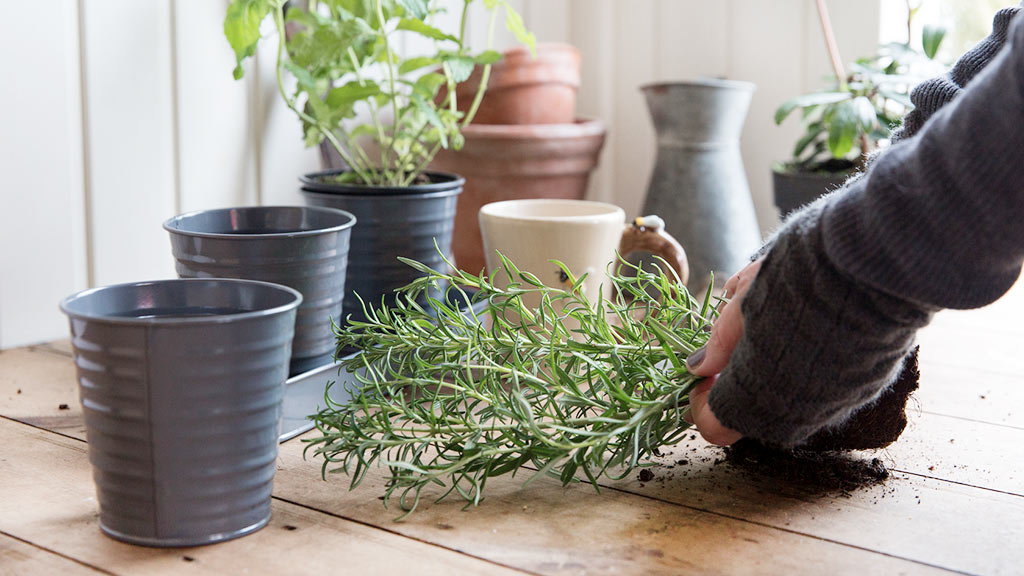Nourish
SPRING KITCHEN HACK: PLANT AN INDOOR HERB GARDEN
Even if it’s not quite time to plant an outdoor garden in every region of the country, you can start an indoor herb garden today—no matter the weather. With just potting soil, seeds, a container, and a sunny spot, you can grow flavor and nutrients to add to your daily meals.
Once the weather warms up, you can move the herbs outside—but we often opt to keep them in the kitchen. Why? Having fresh herbs at the ready makes them easy to snip on a whim, which means we’re more likely to toss them into whatever we’re cooking. Plus, the burst of green boosts our mood. A win-win!
Here are our four favorite herbs to grow indoors (green thumb not required).
PARSLEY AND CILANTRO
With vitamins A and C, as well as iron, these two versatile herbs are some of the easiest to grow indoors. Simply plant the seeds according to the package directions in a pot filled with freely draining potting soil, and place near an east- or west-facing window. Let the surface of the soil dry between watering.
Try in:
Green Detox Smoothie
Spring Nourish Bowl
Tamari Lemon Edamame Salad
CHIVES
Add fresh flavor (and vitamins A and C) to dishes like eggs and salads with snipped chives from your very own indoor kitchen garden. Look for small chive plants at your farmer’s market, local nursery, or garden store, and plant in a small planter box or pot. Position in a window facing east or west with a few hours of direct sun a day, and keep the soil moist for a plant you can enjoy all year long.
Try in: Omelets, egg salad, green salads, or sprinkled over hummus.
GINGER
Cut off a piece of tummy-soothing, anti-inflammatory organic ginger root from the store and plant in a combination of compost and potting soil for your very own crop. For best results, keep the pot in a warm (but not hot), draft-free spot that gets indirect light and has a temperature of about 70 degrees.
Try in:
Golden Milk Smoothie
Chicken Tikka Masala
Ginger Broiled Fish
MINT
If you’ve ever had mint growing in your garden, you know that it usually tries to take over. What can feel like a nuisance outdoors is actually a bonus indoors—it’s remarkably easy to grow. Mint contains Vitamins A and C and iron, and it’s easy to start from seed. Position a pot in a sunny spot and pinch the plants back regularly if (when) it starts to take over the room.
Try in:
Ginger Mint Honey Mocktail
Hearty Brussels Sprout Apple Salad
Even if it’s not quite time to plant an outdoor garden in every region of the country, you can start an indoor herb garden today—no matter the weather. With just potting soil, seeds, a container, and a sunny spot, you can grow flavor and nutrients to add to your daily meals.
Once the weather warms up, you can move the herbs outside—but we often opt to keep them in the kitchen. Why? Having fresh herbs at the ready makes them easy to snip on a whim, which means we’re more likely to toss them into whatever we’re cooking. Plus, the burst of green boosts our mood. A win-win!
Here are our four favorite herbs to grow indoors (green thumb not required).
PARSLEY AND CILANTRO
With vitamins A and C, as well as iron, these two versatile herbs are some of the easiest to grow indoors. Simply plant the seeds according to the package directions in a pot filled with freely draining potting soil, and place near an east- or west-facing window. Let the surface of the soil dry between watering.
Try in:
Green Detox Smoothie
Spring Nourish Bowl
Tamari Lemon Edamame Salad
CHIVES
Add fresh flavor (and vitamins A and C) to dishes like eggs and salads with snipped chives from your very own indoor kitchen garden. Look for small chive plants at your farmer’s market, local nursery, or garden store, and plant in a small planter box or pot. Position in a window facing east or west with a few hours of direct sun a day, and keep the soil moist for a plant you can enjoy all year long.
Try in: Omelets, egg salad, green salads, or sprinkled over hummus.
GINGER
Cut off a piece of tummy-soothing, anti-inflammatory organic ginger root from the store and plant in a combination of compost and potting soil for your very own crop. For best results, keep the pot in a warm (but not hot), draft-free spot that gets indirect light and has a temperature of about 70 degrees.
Try in:
Golden Milk Smoothie
Chicken Tikka Masala
Ginger Broiled Fish
MINT
If you’ve ever had mint growing in your garden, you know that it usually tries to take over. What can feel like a nuisance outdoors is actually a bonus indoors—it’s remarkably easy to grow. Mint contains Vitamins A and C and iron, and it’s easy to start from seed. Position a pot in a sunny spot and pinch the plants back regularly if (when) it starts to take over the room.
Try in:
Ginger Mint Honey Mocktail
Hearty Brussels Sprout Apple Salad










One person has left a comment. Join the conversation!
View Comments